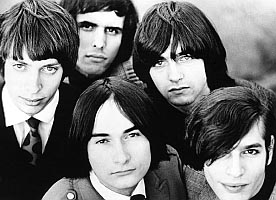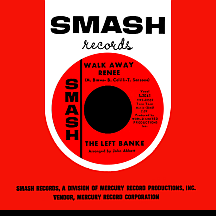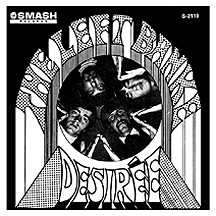THE LEFT BANKE
Walk Away Renee
France's River Seine has its affluent neighborhood on the Right Bank where the waterway flows through Paris and, on the other side, the bohemian Left Bank frequented by artists and wayfarers, both districts irresistibly fascinating to tourists. This has nothing, in particular, to do with New York City's pop-rock band The Left Banke, who adopted the name for its trendy, artsy connotation. The sometimes-four, sometimes-five member group certainly fell in line with the perceived essence of both banks, vagabond musicians and students on the left with a touch of the upper-crust right bank classical artiste. But let's get real: these guys were American all the way and teenagers to boot, as such prone to rash decisions and juvenile conflict, behavior that will stack the odds against prolonged survival every time. A talented bunch, I must say, to overcome such handicaps as youth imposes and create at least a few lasting pieces of music.
The Left Banke grew out of three earlier bands. Bassists Tom Finn and George Cameron (who also played drums) were members of, respectively, The Castels and The Morticians; Finn was also part of The Magic Plants, whose Verve 45, "I'm a Nothing," appeared near the end of 1965. This led to an acquaintance with Harry Lookofsky, a concert violinist-turned-jazz arranger whose piano and harpsichord-playing son Michael Lookofsky (Mike Brown his chosen professional name) was looking for an outlet for his songwriting. A singer, Steve Martin, came on board and the four-piece outfit, taking advantage of the elder Lookofsky's connections, signed with Mercury Records.
"Walk Away Renee," written by Brown and two of his friends, Bob Calilli and Tony Sansone, came as the result of an infatuation Mike had with Tom Finn's girlfriend. The classically-conceived composition, produced by Lookofsky and featuring a string section, was released on Mercury subsidiary Smash and caught on fast in the fall of '66, a top ten hit that reached number two on the Cash Box chart in November (instant phenom The Monkees' first hit, "Last Train to Clarksville," obstructing their view of the summit). It was followed by another hit, "Pretty Ballerina," written entirely by Brown and inspired, as before, by the alluring Renee (and here I just thought it was about a centuries-old equivalent to a stunning '60s go-go girl!). She wasn't actually a ballet dancer, but this attention she was receiving must have tested Tom's cardiac fortitude.
Trouble was brewing! Brown felt the others were performing below acceptable levels; by the time "Ballerina" peaked (top 20 in early '67), its classical combo and Brown's use of flat piano notes particularly effective, he had removed himself from the fivesome...then had the chutzpah to start his own preferred version of the Left Banke, keeping it hush-hush for a time. The original foursome added guitarist Rick Brand in time for him to be photographed on the front and back covers of their debut album with Steve, Tom, George and Mike all shown feigning unity. Critics were quick to slap a label on their brand of music, calling it "baroque pop," not a particularly exclusive concept (The Beatles, for example, had already ventured into the same territory with "Yesterday" and "Eleanor Rigby"); the album's liner notes by writer-professor Jere Real trumpeted: "...in their effort to go for Baroque, they've succeeded in making many trips to the bank(e). The one on the left, that is."
The group recorded an art-pop rendition of the "Things Go Better With Coca Cola" radio commercial. Then Leonard Bernstein, on the April broadcast of his CBS special Inside Pop: The Rock Revolution, professed his admiration of "Pretty Ballerina" (explaining how "This tune is built, not in the usual major or minor scale, but in a combination of the Lydian and Mixolydian modes! Imagine that!"). Heavy, man! It seemed there would be more hits to follow the one-two punch, but the situation got tangled when the third single, "Ivy, Ivy" (a recording made without Finn, Cameron, Martin or Brand) suddenly arrived on Smash, sounding nothing like the group (that's not Steve singing!); Brown had teamed with Bert Sommer (later a cast member in the Broadway production of Hair, performer at Woodstock and minor hitmaker with "We're All Playing in the Same Band," all in 1969 and '70). So the Left Banke found itself split into two factions (not unlike The Dell-Vikings/Del Vikings situation of a decade earlier); it might have been a good time to institute the Right Banke as an alternate moniker and avoid the inevitable. But that would be too easy.
Original Bankers Cameron, Finn and Martin cried "Foul!" and they came close to getting some money-siphoning lawyers involved. Parties on both sides seemingly reconciled...though momentum had been lost, unfortunately never to be regained. One nice perk for Brown and Sommer came when a more mainstream version of the "Ivy" flip, "And Suddenly," by D.C.-area band The Cherry People, was a fair-sized hit in the summer of '68...and greenbacks gained from songs composed are always welcome. The new, jumbled Left Banke lineup struggled to be creative and avoid altercation in those late months of 1967 with fringe musicians coming and going. "She May Call You Up Tonight," composed by precarious collaborators Brown and Martin, did little to revive interest at radio.

"Desirée" was accompanied by trade ads showing four - but which four? - of the band members in a peculiar circular photo, proclaiming them "A great group back together again," as if they'd broken up, in essence putting a question in fans' minds as to whether something had gone amiss, which of course it had. The uptempo Mike Brown-Tom Feher track delivered false hope, briefly, when it hit the charts...then dropped out of sight. Brand cried "Uncle!" and quit; Brown also departed for the second, but not last, time. A friend, Steven Tallarico of Chain Reaction, a group with singles on the Date and Verve labels (you know him as Steven Tyler, eventual superstar lead singer of Aerosmith), was present at the 1968 recording session for the single "Dark is the Bark" and "My Friend Today" and though not documented, it's widely believed he sang backup harmony on these two somber Left Banke sides and one other track. Motown's Four Tops hit the airwaves around this time with their remake of "Walk Away Renee," taking it top 20...and more money came rolling in for Brown and his non-Banke buddies. Good for them, since songwriting royalties would soon be about the only income derived from the Left Banke's relatively short stretch, though it was Brown who received most of it. Fair or not? You be the judge!
There were a few more singles in 1968 and early '69. Persistent pesterer Brown jumped in a third time; the others were, like, "Whatever!" and let him. "Myrah," essentially a Brown solo effort, became the last Smash single under the Left Banke name. The record stiffed and what was left of the band came undone. A single by Steve Cameron, "Two By Two (I'm Losing You)," written and produced by an apparently grownup Michael Brown, surfaced on the Buddah label in 1971. Then Mike became a founding member of Stories, scoring a minor hit, "I'm Coming Home," in the summer of '72, after which he quit as was his wont and, with "Brother Louie" a chart-topper the following year, Stories went on to fame and fortune without him. In 1978, George Cameron, Tom Finn and Steve Martin returned as The Left Banke with a single, "Queen of Paradise," on the Camerica label; an entire album of material was recorded but not released. The three key members resumed their regular, baroqueless day-to-day lives but have since reunited.



